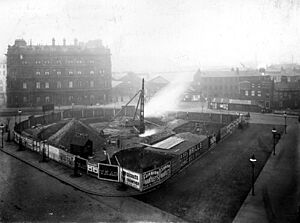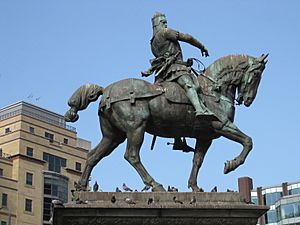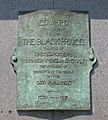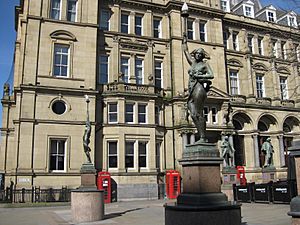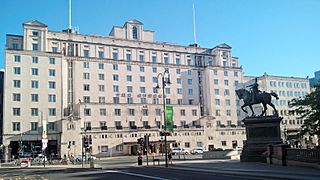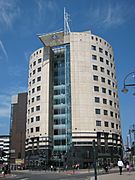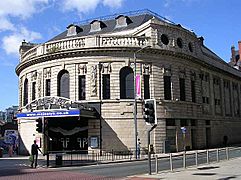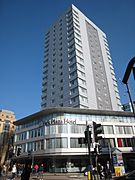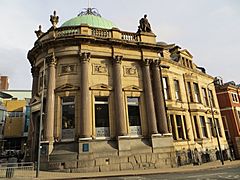City Square, Leeds facts for kids
City Square is a special paved area in the city of Leeds, England. It's located just north of the Leeds railway station. Six different roads meet here, making it a busy and important spot in the city centre. The only building that faces directly onto the square is the old General Post Office.
History of City Square
Ideas to improve the area in front of the train station started in 1893. After some old buildings were taken down, a new space opened up. The new General Post Office was built here in 1896, with a public square in front of it.
At first, some people wanted to name the square after a famous local engineer, John Smeaton. However, the city council (the group that runs the city) decided to call it City Square. This was because Leeds was officially becoming a city that same year!
The first plans for the square included waiting rooms for trams and public toilets. But the Lord Mayor of Leeds at the time, Colonel Thomas Walter Harding, didn't like this idea. He hired an architect named William Bakewell to design a more beautiful square. He wanted it to look like an Italian piazza, with statues and trees.
During the Second World War, Leeds was attacked by planes from Germany (the Luftwaffe). City Square was hit by a bomb. There was a public air raid shelter (a safe place during air attacks) in the square, but it was badly damaged.
In 1997, most of the traffic, like buses and taxis, was moved away from City Square. This was part of a new traffic plan for Leeds city centre. The square was then updated in 2003. One side was closed to cars, the statues were moved around, and fountains were added. The fountains were later removed in 2013.
Statues in City Square
All the statues in City Square are made of bronze and are larger than real life. They were put there to celebrate Leeds becoming a city. Most of them are considered important historical artworks.
The Black Prince Statue
The biggest statue is of Edward, the Black Prince (1330–1376). He was an English prince and a famous warrior. This statue was created by Thomas Brock. The prince didn't have a direct connection to Leeds, which caused some discussion at the time.
The statue stands on a base with pictures carved into it. These pictures show some of the prince's famous battles. Colonel Thomas Walter Harding paid for this statue and most of the others. It took seven years to make and was so big it had to be cast (shaped) in Belgium. It traveled by sea to Hull and then by boat along the River Aire to Leeds. It was officially shown to the public on September 16, 1903, to cheering crowds.
Other Important Statues
There are several other statues of important people in City Square:
- James Watt: He was a famous engineer, even though he didn't live in Leeds. His statue was put up in 1903.
- John Harrison: He was a local cloth merchant and helped Leeds a lot. He built a church and a school. His statue was also put up in 1903.
- Dr Walter Hook: He was a vicar (a type of priest) in Leeds. He helped rebuild the main church and built many schools. His statue was put up in 1902.
- Joseph Priestley: He was a famous chemist and lived in Leeds for a few years. He did experiments with gases using carbon dioxide from a local brewery. His statue was put up in 1903.
Eight Nymphs
There are also eight statues of female figures called "Nymphs." They were made by Alfred Drury. These statues come in two types: "Morn," holding a lamp and flowers, and "Even," holding a lamp and touching her head.
They were first placed in a circle around the Black Prince statue. In 1956, they were moved into two rows. In the 1990s, there was a plan to remove them completely because some people didn't think Victorian art was valuable. But people fought to keep them, and now they are arranged in a three-quarter circle.
Buildings Around City Square
General Post Office
The old Leeds General Post Office building is on the northwest side of the square. It's a beautiful building with a classical style, designed by Sir Henry Tanner. It has four floors and a central clock tower. There are two main entrances with columns.
It opened on May 18, 1896. Above one entrance, there are two figures representing "Reading" and "Writing." Above the other, there are figures for "Reading" and "Philosophy." Higher up, there are four more figures that are said to represent Time, Air, Light, and Earth. You can also spot two owls on the front of the building! The red telephone booths outside are also considered historical.
Other Buildings Nearby
Many other interesting buildings surround City Square:
- The Queens Hotel is on the south side.
- The Mill Hill Chapel is on the east side. A modern sculpture called "Legs walking" was placed outside it in 2018.
- No. 1 City Square is a modern skyscraper built in 1998.
- The old Majestic Cinema and Ballroom (built in 1921) is on the southwest side. It's made of special terracotta.
- The Park Plaza Hotel is on the southeast corner.
- The former Yorkshire Bank building (built in 1899) is now a bar. It's made of granite and has a unique copper dome.
White Rose Way
City Square is the official starting point for a long walking path called The White Rose Way. This path is 104 miles long and ends in Scarborough, North Yorkshire.



